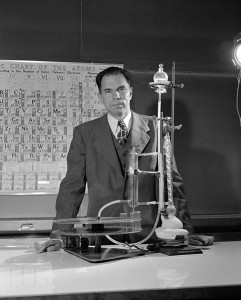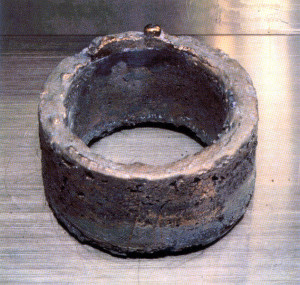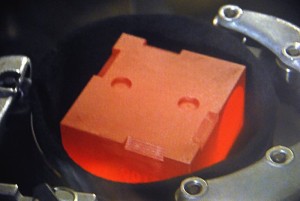SciTech Tuesday: Plutonium’s discovery
Plutonium, the element used to power the Fat Man bombs used for the test at Trinity and for the
bombing of Nagasaki, was discovered on February 23rd, 1943. A group of scientists at UC Berkeley bombarded uranium with deuterons (the nucleus of a heavy hydrogen isotope, made up of a proton and a neutron), and observed that it had an atomic number of 94 and was chemically distinct from uranium. This team, led by Glenn Seaborg, sent a research paper describing their investigation to a journal, but publication was delayed until after World War II for security reasons. Theoretical calculations by researchers at the Cavendish Laboratory in England indicated that plutonium (Pu in the periodic table) could be used for powerful critical nuclear reactions, and would be produced as a by-product in uranium reactors.
Much of the Manhattan Project’s efforts were to create plutonium, and to separate it from uranium. It did prove to be a better source of fission energy than uranium. Today’s nuclear weapons have plutonium cores.
Plutonium is very reactive, and in air will form a flaky substance that spontaneously ignites. Because it is so reactive it is toxic, and unlike uranium accumulates in bones. These properties make it much more dangerous than uranium.
239Pu is the isotope used primarily for fission. It has a half-life of about 24,000 years. 238Pu has an extremely high decay heat, and so is often used to produce special generators that use heat to power satellites and space probes. It has a half-life of about 88 years. 240Pu has a high spontaneous fission rate, and so is not suited for weapons use. There are two other isotopes of plutonium (241Pu and 242Pu) that mostly present radiation hazards in waste. All isotopes decay to an isotope of uranium but 241Pu (becomes an isotope of americium).
As an expert in plutonium, Seaborg was placed on leave from Berkeley and sent to work at the

A young Glenn Seaborg posing in front of a Periodic Table showing gaps which would eventually be filled with elements he would help discover.
ChicagoMetallurgical Laboratory (a secret part of the Manhattan Project) for the duration of the war. The discovery of plutonium was only a small part of his illustrious career. He was involved in the discovery of several other elements, became chancellor at UC Berkeley, was chairman of the US Atomic Energy Commision, and served on the presidential commission that produced the famous Nation at Risk report on the failings of educational policy in the US. He won the Nobel Prize in Chemistry in 1951 and died in 1999.
Posted by Rob Wallace, STEM Education Coordinator at The National WWII Museum






Leave a Reply